When it comes to pure strategy articles, the more thorough the writer is, the better. In Alex Brown’s articles, he lays out nothing short of a complete, precise blueprint of instructions. He provides everything you’ll need to know: different builds for one specific deck, card combos and interactions, game play, and matchups. The top page of Metagame says “Take Your Game to the Next Level,” and Alex Brown is a writer who excels at helping readers achieve that.
Listed below is Alex’s two part Teen Titans series reprinted as one article. - TW

Since Pro Circuit New York, there have been several interesting developments in the Golden Age metagame. The banning of
Overload and the neutering of the Light Show decks centered on
Rama-Tut and
Dr. Light, Master of Holograms were big moves. Green Lantern and Marvel Knights builds emerged as top tier contenders. Finally, the most anticipated set since
Marvel Origins,
The Avengers, has players scrambling to fit out their newest ideas before the next PCQ or $10K reaches their area.
Before I go any further, I want to put a few things in context for you. Two decks, regardless of whether they win every tournament, dominate the current Golden Age metagame. Those decks are Curve Sentinels and Teen Titans. Knowing how these decks operate will give you the necessary grounding to either pilot them to success or maximize your chances of defeating them. While I intend to cover Curve Sentinels in the near future, I have a bit more experience with the Teen Titans, so I’ll begin with them.
Teen Titans is the most flexible and synergistic affiliation. Whereas most affiliations have obvious and narrow themes, the Teen Titans have access to a wondrous collection of abilities. While their capacity for devastating team attacks and ability to stun characters outside of combat are the Titans’ most lethal hallmarks, their access to ancillary benefits—such as direct endurance loss, KO’d pile manipulation, and numerical supremacy—contributes substantially to their impressive package.
Perhaps because of the range of options available on each turn, the Teen Titans are commonly considered to be difficult to play. This may be true for the uninitiated; however, for more experienced players, the deck is hardly indecipherable. With this article and the following matchup guide, I want to highlight the important issues and tensions within today’s Teen Titans builds. For the sake of brevity, unlike my last series on the League of Assassins, this article will not seek to detail every possible card selection or inquiry you may have. This week, I want to look at the affiliation first from a historical perspective. From there, I will give my current build, explaining where I differ from the norm and for what reasons. For beginners, I have written on this subject in a more elementary fashion before, so if you are interested, you can follow on from the footnote*.
The Teen Titans have tasted success at every level of the game. Looking back at the lists that cemented the Titans in the top tier shows us how some of the better players in the game have approached the deck. From there, we will be able to make our own decisions with regard to the most up-to-date build.
Jason Green
7-0, Day 1 PC Indy 2004
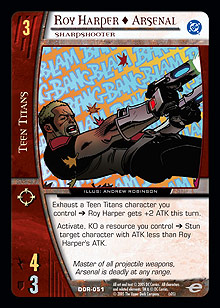 Characters
Characters
4 Beast Boy
2 Connor Kent ◊ Superboy, Tactile Telekinetic
4 Dawn Granger ◊ Dove
4 Garth ◊ Tempest
3 Hank Hall ◊ Hawk
1 Koriand’r ◊ Starfire
4 Red Star
4 Roy Harper ◊ Arsenal, Sharpshooter
4 Terra
4 Tim Drake ◊ Robin, Young Detective
Plot Twists
3 Heroic Sacrifice
4 Not So Fast
3 Overload
4 Teen Titans Go!
Locations
4 Tamaran
4 Titans Tower
3 USS Argus
2 Optitron
Jason took his list to an undefeated record on the first day of the inaugural Pro Circuit, PC Indy 2004. At the time, Vs. was almost strictly a combat-oriented game, and this list responds to that by including four copies of Titans Tower and three Heroic Sacrifices. The early rise of Overload was clearly evident, and Jason has his own as well as the maximum available copies of Not So Fast. Where Jason’s list really comes into its own is its Terra count. While her power level is common knowledge now, Terra was tech at this event. Great against weenie and utility decks and pivotal in the important task of dominating an as-yet undefined mirror match, Terra put Jason’s list over the top. Current builds are much different, but we can see the raw power of the affiliation rearing its head even at this early stage.
Ryan Jones
PCLA 2004 Champion
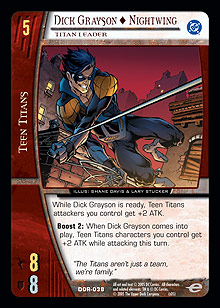 Characters
Characters
1 Cassie Sandsmark ◊ Wonder Girl
1 Connor Kent ◊ Superboy, Tactile Telekinetic
3 Dawn Granger ◊ Dove
1 Dick Grayson ◊ Nightwing, Titan Leader
4 Garth ◊ Tempest
3 Hank Hall ◊ Hawk
1 Koriand’r ◊ Starfire
3 Red Star
4 Roy Harper ◊ Arsenal, Sharpshooter
4 Terra
4 Tim Drake ◊ Robin, Young Detective
Plot Twists
3 Finishing Move
2 Foiled
2 Heroic Sacrifice
2 Ka-Boom!
2 Overload
3 Press the Attack
3 Savage Beatdown
3 Teen Titans Go!
Locations
2 Optitron
3 USS Argus
3 Tamaran
3 Titans Tower
This is probably the most famous of all Teen Titans incarnations. Ryan took out the second Pro Circuit with a list and style that had been popularized by then-teammate Rob Leander. Superficially, the numbers of the deck seem to lack focus. However, the redundancy of the attack plan—built around Tim Drake and Teen Titans Go!—and the defensive plan—built around Roy Harper and Press The Attack—granted Ryan a lot of freedom to factor in an unrivaled support cast. Although the lists would gradually tighten up, this deck provides the foundation for future Teen Titans builds.
Adam Prosak
$10K San Diego Champion
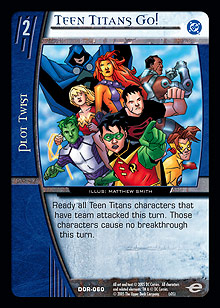 Characters
Characters
1 Pantha
2 Roy Harper ◊ Speedy
2 Dawn Granger ◊ Dove
3 Hank Hall ◊ Hawk
4 Tim Drake ◊ Robin, Young Detective
4 Roy Harper ◊ Arsenal
2 Beast Boy
4 Terra
2 Red Star
4 Garth ◊ Tempest
2 Koriand’r ◊ Starfire
Plot Twists
4 Teen Titans Go!
4 Press the Attack
4 Finishing Move
2 Ka-Boom!
2 Heroic Sacrifice
2 Savage Beatdown
Locations
4 USS Argus
4 Tamaran
4 Optitron
Adam has strong views on card counts and deck building that have influenced the design of his deck**. Renowned for his longtime dedication to the affiliation, Adam was recently rewarded for his efforts with a first place finish at $10K San Diego. His deck is similar in templating to the Jones/Leander builds of the past. However, in the post-Overload environment, Adam has streamlined his non-character selection to focus on what he considers integral to the proper function of the deck.
So where does that brief history lesson leave us?
Alex Brown
Teen Titans August 2005
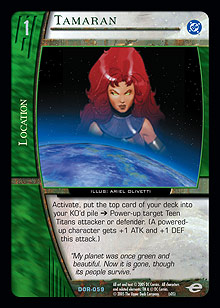 Characters
Characters
1 Pantha
4 Tim Drake ◊ Robin, Young Detective
4 Roy Harper ◊ Arsenal, Sharpshooter
3 Hank Hall ◊ Hawk
3 Dawn Granger ◊ Dove
3 Beast Boy
4 Red Star
4 Terra
4 Garth ◊ Tempest
Plot Twists
4 Teen Titans Go!
4 Press the Attack
4 Finishing Move
3 Foiled
2 Heroic Sacrifice
1 Betrayal
Locations
4 USS Argus
4 Tamaran
4 Optitron
I would hope this is read not merely as a list forged from my own experiences***, but also by close examination of the builds given above. The following paragraphs will outline what I think are the important issues for the deck and how I feel they should be resolved. I will explain where I depart from conventional wisdom, and why.
Foiled vs Ka-Boom!
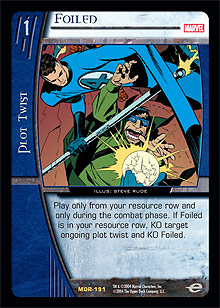 Foiled and Ka-Boom! offer two powerful effects. If a deck can support it, the ability to KO a resource—quite distinct from replacing it—can be game-winning. Combined with Garth ◊ Tempest, we have the makings of a soft-lock for decks that rely on either locations or ongoing plot twists. While there is no question that the Titans, with their ability to play off curve and repeat drops, can support such a plan, there is no consensus as to the number of each that a player should run.
Foiled and Ka-Boom! offer two powerful effects. If a deck can support it, the ability to KO a resource—quite distinct from replacing it—can be game-winning. Combined with Garth ◊ Tempest, we have the makings of a soft-lock for decks that rely on either locations or ongoing plot twists. While there is no question that the Titans, with their ability to play off curve and repeat drops, can support such a plan, there is no consensus as to the number of each that a player should run.
I advocate three copies of Foiled and no Ka-Boom!s. I think the deck can only afford to give up a maximum of four slots to these cards before it loses too much punch, and that you need to run at least three copies to reliably draw one. Put simply, Foiled just outright wins you more games than Ka-Boom! does. Ka-Boom is useful, but locations tend to be more incidental than mandatory. Ongoing plot twists, particularly team-ups, are more often critical to your opponent’s plans. Specifically, Total Anarchy is one of the best answers to a Titans deck. I will concede that both cards are fine; I merely think that Foiled is the more devastating option.
Red Star and Terra Counts
Some affiliations struggle along without an acceptable second-choice 4-drop. Not the Titans. The Teen Titans have access to two different but powerful options on the fourth turn. Red Star shines against Curve strategies. In combination with Tim Drake, Teen Titans Go!, and Tamaran (or simply an old-school power-up), you can wipe out an opponent’s board without losing a man. His capacity for direct endurance loss can finish off an opponent or simply turn up the pressure. On the other hand, Terra annihilates decks that rely on weenie rushes or key small characters such as Shimmer.
There is much debate as to how many of each you should run. In my opinion, you want to run the maximum of each. Red Star and Terra are both critical to the different plans you want to carry out. Red Star is often just as potent on later turns, and Terra is the dominant reason why some match-ups—like TNB—are grossly in your favor. It always helps having greater numbers early on so you can mulligan aggressively, and if you are forced to use Roy Harper ◊ Arsenal, Sharpshooter prematurely, you have an acceptable drop to fill in.
Location Selection
Perhaps the greatest area of consternation for the Titans deck builder is location selection. Terra requires a significant number of locations to be reliably effective. Fortunately, there are quite a few to choose from.
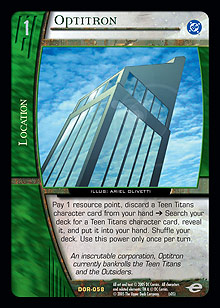 I have long been a fan of USS Argus, which I see as more than a one-turn effect to be replaced by Terra. I find that the Titans play more like a combo deck, where you need to assemble the critical parts in a given matchup to force through the win. Gaining card advantage is not irrelevant, but Garth is sufficient in carrying out that function. I feel that USS Argus, in combination with Optitron, brings a consistency to the deck that other single-affiliation decks cannot match. Unless I have every card I need in my hand, I flip USS Argus as soon as possible, whether I have Terra or not. If you haven’t established a game-winning position by the end of turn 6, when the card disadvantage starts to hurt, you were unlikely to win anyway. USS Argus is a definite four-of.
I have long been a fan of USS Argus, which I see as more than a one-turn effect to be replaced by Terra. I find that the Titans play more like a combo deck, where you need to assemble the critical parts in a given matchup to force through the win. Gaining card advantage is not irrelevant, but Garth is sufficient in carrying out that function. I feel that USS Argus, in combination with Optitron, brings a consistency to the deck that other single-affiliation decks cannot match. Unless I have every card I need in my hand, I flip USS Argus as soon as possible, whether I have Terra or not. If you haven’t established a game-winning position by the end of turn 6, when the card disadvantage starts to hurt, you were unlikely to win anyway. USS Argus is a definite four-of.
Because of the importance of the Argus, I don’t play with Titans Tower anymore. Its effect is strong, but I find that between Teen Titans Go! on offense and Arsenal on defense, I just don’t need it anymore. Considering my plan to aggressively use USS Argus, I can’t really afford the extra card, either.
I value Optitron very highly. Playing four copies allows me to aggressively mulligan for access to Tim Drake on turn 2, which I think is the key to the archetype. It doubles as insurance for getting to Arsenal in the late game, where he is sorely needed, and it can give you extra copies of Red Star and Tim Drake, which can be crucial. The general off-curve nature of the Titans deck really breaks this card open, and I am surprised more players don’t play the maximum number of copies.
For a long time, I was not really a fan of Tamaran, but I finally came to my senses. Not only does the card obviously facilitate the busted antics of Red Star/Tim Drake, it protects your early investments by keeping their average bodies above the curve. Later on, Terra and Garth can both stay out of stun range with a timely flip and power-up. It also provides locations nine through twelve for me; I feel twelve is the right number to support Terra.
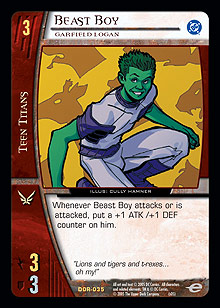 Beast Boy
Beast Boy
While the last issue may have been more generally controversial, for a long time, I had been alone in my advocacy of Beast Boy. Rumors of his susceptibility to Overload were greatly exaggerated, because if you weren’t running Not So Fast, you would rather have your alternate 3-drop stunned on turn 5 than lose Roy Harper or Tim Drake.
I make no bones about it: Beast Boy is still your third choice at the drop. However, one of the least efficient and unduly popular answers to this deck is Flame Trap, and you don’t want to get caught by it by overextending with Hawk/Dove on turn 3. Of course, in matchups where this isn’t relevant, they are the preferred play (though Roy is always the safe play).
That Beast Boy has flight is also far from irrelevant, though the main reason I include three copies of him is less obvious. As stated above, I think hitting Tim Drake on turn 2 is critical, so I mulligan aggressively for him or Optitron. I will throw any other hand, period. I’ve had to tweak the decklist a bit to get away with it, but I think it’s worthwhile. By essentially moving to thirteen 3-drops, between them and USS Argus I can get Tim without worrying about my 3-slot.
Press the Attack
I only moved to four copies of Press after Adam won $10K San Diego, but I cannot believe I didn’t do it earlier. There have been so many games where I only needed a Press the Attack to win and couldn’t get it. Multiple uses of Roy or Terra are obvious and recommended, but Press the Attack also allows you to wipe out your opponent’s characters with Tim Drake/Red Star and friends, leaving behind a single character to repeatedly attack directly. Press the Attack is one of the more inherently “broken” effects the game offers. Some argue that it really only helps you win more, so you don’t need it all the time; I counter that it often helps you win “a turn more,” so it is worth the extra slot. You simply need it sometimes, and I recommend running the maximum number.
Finishing Move
One of the interesting things about Finishing Move is that sometimes when you have it, you play towards using it when you should be playing to force through extra endurance loss. Board control is only a means to achieving endurance loss, and not an end in itself, but for those beyond such temptations, this is a powerful card. In combination with Terra and Roy Harper, it can break you out of A Child Named Valeria locks. Because of the numerical supremacy inherent in the team (typified by Hank/Dawn), it can be used to gain advantage very early on. Against Curve decks, it can remove characters to relieve pressure on non-initiative turns. Key smaller characters can also be removed to dent an entire strategy.
Four copies may seem like overkill, but I think you need to have it all of the time. I will concede that drawing the second copy is rough, but it is not useless. The advantage provided by Finishing Move is too easily exploited in this affiliation; one of the most powerful generic cards in the game would be a terrible waste if not fully utilized here.
Roy Harper ◊ Speedy
I have played this card a lot, and I have never liked it. I can see where it would be good, but decks that rely on 1-drops have left center stage in this format. Even in matchups where Speedy is relevant, he is only good very early on, which often requires Optitron for second turn play. In a one-game format, this is a very risky strategy. If I thought the payoff was worth it, I would still include a copy, but I am unconvinced. Typically what Speedy can achieve is easily attained, if belatedly, by pressure with Hawk/Dove/Tim and Teen Titans Go!. Pantha is a better one-of character to fill the breach.
Koriand’r ◊ Starfire
Players will often forget about Koriand’r, but I still think you have to get pretty lucky to be able to use her. Sometimes just having a large body is better, and you still need to fulfil the character requirement. That she can’t be searched out until turn 7 is a bummer, considering you would probably have wanted to use Arsenal before then.
I think including Koriand’r is a matter of play style. With my four Optitrons and three Beast Boys—as well as full complements of Terra and Red Star, and a copy of Pantha—I have a lot to do in the late game. Typically, I like to use Roy on turn 5 or 6 to ensure I get to my team attack turn expediently. This doesn’t leave a lot of room for Koriand’r. Drawing her early on without an Optitron is suicide, so I prefer to leave her out.
Savage Beatdown
For a long time, Savage Beatdown was a staple of my Teen Titans builds. Although its stock dropped considerably with the removal of Overload, it is still far from useless, as it is a fantastic target for Garth and obviously the best card in the game for ensuring a stun.
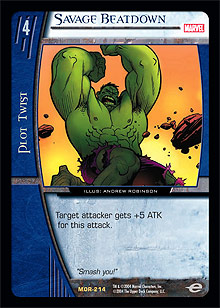 Recently, however, I find it does very little for me, and its effect is random because I can’t afford to devote the slots to making it frequently available. With my remaining slot, I went for Betrayal, as it is very good against your average Sentinel player and is more likely to outright win you the game. I find that nowadays, between Finishing Move and my bolstered Red Star plan, I just don’t make risky attacks–I either team attack repeatedly, or I team attack and KO. Of course, this is only against Curve decks, but that was the only place Beatdown was relevant anyway. I can understand arguments in favor of its reinstatement, but if those arguments win out, more than two copies are needed.
Recently, however, I find it does very little for me, and its effect is random because I can’t afford to devote the slots to making it frequently available. With my remaining slot, I went for Betrayal, as it is very good against your average Sentinel player and is more likely to outright win you the game. I find that nowadays, between Finishing Move and my bolstered Red Star plan, I just don’t make risky attacks–I either team attack repeatedly, or I team attack and KO. Of course, this is only against Curve decks, but that was the only place Beatdown was relevant anyway. I can understand arguments in favor of its reinstatement, but if those arguments win out, more than two copies are needed.
I hope I have shed some light on the evolution of the Teen Titans in Golden Age. If you have any queries, feel free to email me at uly233@hotmail.com, where I promise to reply to any legitimate questions you may have. Until then, don’t blame me if you pass your recruit on turn 2.
*I wrote an earlier, more comprehensive expose on the Teen Titans at VsParadise.com. If you search the Columns of that site, you will be able to find it easily. In addition, there is a rather outdated matchup guide that was written for a different metagame, and was even then quite possibly misguided. I would still recommend reading it, because if you can see where that information is now wrong (and was quite possibly wrong then, too), you will be better equipped to play the deck yourself.
**Adam is a Featured Writer for VsUniverse.com.
***Top 8 appearances at $10K Sydney, $10K Melbourne and $10K Brisbane.

Understanding matchups is one of the most critical skills that any player can develop if he or she wants to be better at Vs. System. Knowing how card values shift when played against different strategies will allow you to deploy and answer threats more efficiently than your opponent.
Before we get down to business, here’s a quick word on identifying matchups. In many of the articles I read and in many of the conversations I have with other players, a dangerous assumption is often employed. Too many people assume that they know what their opponent is playing straight away. In the one-game format, this can be a very costly assumption. If an opponent plays She-Thing on turn 2, is that person playing Common Enemy or Fantastic Fun? Or maybe even plain FF Curve? At some point or another, you have to put your opponent on something; however, I want to point out from the outset that this is rarely a fixed state of affairs. Be careful without being too conservative. Be prepared to change your mind sometimes.
As a recap, here’s the list I posted in my last article:
Alex Brown
Teen Titans August 2005
I will be referring to this list throughout the article. I’m far from convinced that it is definitive and I welcome any supported criticism. That said, I still need to anchor my views somewhere.
Versus Curve Sentinels
This matchup is probably the most misunderstood issue in Vs. System. Ryan Jones recently wrote an article at VsUniverse.com giving some of his opinions on the subject, and I would recommend it to anyone without an issue against purchasing a premium membership to that site. His general point, with which I agree, is that this matchup is unfavorable for the Titans player. I find particular resonance in his frustration with the popular belief that the Titans deck is just so complex that the pilot must have erred if he or she lost to the lumbering and simplistic Sentinel deck. The matchup is definitely difficult for both sides and involves many nuances, but at its core, it is generally in the Sentinels’ favor.
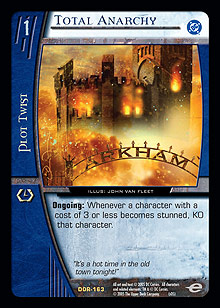 The Titans player is generally well equipped to face the archetypal Curve deck. Builds such as Big Brother typically find themselves shredded by Tim Drake & Co. However, Curve Sentinels is a little more than your average curve deck. Firstly, the Sentinels player is plausibly able to curve out from the first turn. Combined with the threat of Total Anarchy or Micro-Sentinels, the Titans player is given little time to set up the team-attack complex. Furthermore, Search and Destroy and Flame Trap create more uncertainty in the mind of the Titans player, who needs to have a face-up Tim Drake in play when he or she has to win. Thus, one of the most important things to realize, if you are familiar with legal jargon, is that the burden of proof is on the Titans player. The Titans will lose the long game, but when forced to act, they cannot be sure of what sort of defensive measures the Sentinels player has up his or her sleeve. This uncertainty gnaws at the Titans player and makes it very difficult to calculate the win properly.
The Titans player is generally well equipped to face the archetypal Curve deck. Builds such as Big Brother typically find themselves shredded by Tim Drake & Co. However, Curve Sentinels is a little more than your average curve deck. Firstly, the Sentinels player is plausibly able to curve out from the first turn. Combined with the threat of Total Anarchy or Micro-Sentinels, the Titans player is given little time to set up the team-attack complex. Furthermore, Search and Destroy and Flame Trap create more uncertainty in the mind of the Titans player, who needs to have a face-up Tim Drake in play when he or she has to win. Thus, one of the most important things to realize, if you are familiar with legal jargon, is that the burden of proof is on the Titans player. The Titans will lose the long game, but when forced to act, they cannot be sure of what sort of defensive measures the Sentinels player has up his or her sleeve. This uncertainty gnaws at the Titans player and makes it very difficult to calculate the win properly.
And that’s not all the Titans worries in this matchup. Nimrod is a massive threat. So good is Nimrod against this deck that he is often the optimal seventh turn and fifth turn play. Apart from playing around Betrayal, Nimrod counters the uniquely Titanesque strategy of focusing not on the quality or size of the characters, but on the quantity of the characters. Essentially, the repair counter on Nimrod negates a Teen Titans Go! This is bad news for the Titans player, who generally needs not only multiple copies of Teen Titans Go! now, but also has to hit and maintain a perfect curve from turns 2 through 5. While this is easier for the Titans deck than for others, it is generally costly on other resources and leaves little room for bad decisions.
With all of that out of the way, I would like to share my plan of attack against Curve Sentinels. I am going to split this into even and odd initiatives because I think a different plan applies to each. Generally, I want the odd initiative with this deck, but against Curve Sentinels, I want evens. This is relatively easy to get unless you’re playing against a disciple of the Jones school of Sentinels, which advocates evens so that you can Finishing Move/Bastion in the mirror. If so, bad times for you, but the odd initiative plan is below.
 If you have evens, your optimal recruitment plan is Tim Drake, Beast Boy, and then Red Star. You really want a Tamaran here for two reasons. On turn 3, it ensures that the opponent’s Mark II gets stunned if it attacks Tim Drake, making Total Anarchy risky. Alternatively, it keeps Beast Boy out of stun range of the Mark II. On turn 4, the Tamaran will allow you to clear your opponent’s board with Teen Titans Go!, KO’ing the Mark II so that Roy will be active next turn.
If you have evens, your optimal recruitment plan is Tim Drake, Beast Boy, and then Red Star. You really want a Tamaran here for two reasons. On turn 3, it ensures that the opponent’s Mark II gets stunned if it attacks Tim Drake, making Total Anarchy risky. Alternatively, it keeps Beast Boy out of stun range of the Mark II. On turn 4, the Tamaran will allow you to clear your opponent’s board with Teen Titans Go!, KO’ing the Mark II so that Roy will be active next turn.
One of the benefits of having four copies of Optitron in your deck is that you can go off curve when necessary. The threat of Nimrod is so immense that you need to preserve numbers to keep your team-attacks effective for when you need to win. By deploying Roy Harper on turn 5, you are effectively holding the fort. Roy is rarely good in this matchup once Bastion arrives, but on turn 5 he can stun the opponent’s Mark V, leaving him or her with a single attacker and ensuring that you recover the stunned character and ready with the same board. Red Star can burn the opponent with the free endurance point.
On turn 6, you drop Garth, and hopefully you’ll have bought yourself enough time to organize the winning attack, which will require three copies of Teen Titans Go! (recurring one from Garth) and a Garth to the face that’s backed up by Press the Attack. Alternatively, you can dent your opponent’s board enough so that either Betrayal or Heroic Sacrifice can be recurred on the next turn for enough steam to win the game.
On the odd initiative, you are at the mercy of Total Anarchy and Micro-Sentinels a bit more, though a well-timed Foiled will help you out immensely. You are playing for the same position as above, but you’re forced to bring it together a turn earlier. This is often too difficult. On odds, you need to be much more aggressive with Finishing Move, and you may be tempted to take a few more risks, perhaps deploying Hank/Dawn in the face of grave danger. With odds, I would focus less on winning early and more on containment for the turn 7 win. This is harder than it seems, but still attainable.
I feel like I could write another ten thousand words on this topic, but for now I’ll leave it alone. Hopefully I have given a little insight into the most important matchup in Golden Age today. I like to think of this matchup as the best deck (Titans) against the best draw (Curve Sentinels). Curve Sentinels is a much more consistent deck than it is given credit for (even if it’s not as consistent as Titans is), and you should expect it to hit its curve. If it does, you are at your best if you follow the above plan, but much of the time, a good player will be able to beat you anyway. Fortunately, the Titans are still considerably more consistent, and often you’ll just be able to win through Curve’s erratic draws or your opponent’s lack of understanding of the power of evens.
Versus Teen Titans
The Teen Titans mirror can be an excruciating experience. It is fought in two ways. Firstly, whichever player has the odd initiative has a distinct advantage if he or she can land the right draw. Ideally, you want to play Tim Drake and Hank/Dawn, clear your opponent’s board with Teen Titans Go!, recruit Terra and Garth, and lock up the game with Roy Harper the turn after. This is the perfect draw, and only a very good draw from the evens player that involves Tamaran and Finishing Move (without those cards being present for the odds player) can defeat it. My deck list was built to give you a reasonable expectation of landing this draw when the chips are down.
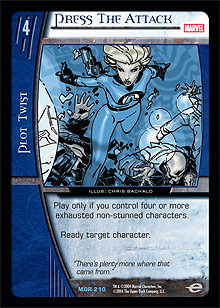 However, many players don’t get that draw or are not canny enough to see how it works. If you are trapped on evens, you’ll find a glimmer of hope if you escape the third turn without serious disadvantage. From there, you should play for numerical supremacy and for the better Roy and Terra. What this means is that Press the Attack becomes the most important card in the mirror. Once that third turn window elapses, Teen Titans Go! is no longer very important.
However, many players don’t get that draw or are not canny enough to see how it works. If you are trapped on evens, you’ll find a glimmer of hope if you escape the third turn without serious disadvantage. From there, you should play for numerical supremacy and for the better Roy and Terra. What this means is that Press the Attack becomes the most important card in the mirror. Once that third turn window elapses, Teen Titans Go! is no longer very important.
The most compelling feature of the Titans mirror is how much even the smallest advantage will lead to a win if not pulled back almost immediately. Unfortunately, there is very little you can do about that except to put your head down and make the right plays. Fortunately, if things aren’t going your way, you will quickly be aware of it and be put out of your misery in short order.
Versus TNB
Some of you might not think this archetype is relevant anymore, but I like to reference it for an important reason. TNB is still the gold standard when it comes to pure rush decks. The stats of its characters and the quality of their support are unlikely to be rivaled in Golden Age. At the moment, GLEE and Titans are both very good against it, and Sentinels (i.e. Nimrod) can hold its own. Understanding how to play a matchup where your opponent hits an aggressive attack curve from turn 1 is an important exercise. Fortunately, the Titans do this better than everyone else does.
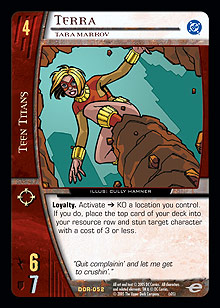 The key to this sort of matchup is always Terra first and Heroic Sacrifice second. Terra can be a ridiculously powerful card. Her ability not only stuns a character, but it also effectively plugs reinforcement channels by removing an attacker who is usually sent in to break them up, thus preventing endurance loss. Heroic Sacrifice is a strange card in that it is extremely powerful, but you will rarely want to play more than one in a match. The prevalence of range among the Titans’ higher drops often means that reinforcing is a good enough option, anyway. However, in matchups where players need to put all of their eggs in one basket by pumping a character with everything they have, you can’t go past Heroic Sacrifice—a Fast Getaway that stuns your smaller characters at the expense of the bigger, harder to recruit ones is always going to be amazing. In the end, you want to be conservative because your cards are just better than theirs are.
The key to this sort of matchup is always Terra first and Heroic Sacrifice second. Terra can be a ridiculously powerful card. Her ability not only stuns a character, but it also effectively plugs reinforcement channels by removing an attacker who is usually sent in to break them up, thus preventing endurance loss. Heroic Sacrifice is a strange card in that it is extremely powerful, but you will rarely want to play more than one in a match. The prevalence of range among the Titans’ higher drops often means that reinforcing is a good enough option, anyway. However, in matchups where players need to put all of their eggs in one basket by pumping a character with everything they have, you can’t go past Heroic Sacrifice—a Fast Getaway that stuns your smaller characters at the expense of the bigger, harder to recruit ones is always going to be amazing. In the end, you want to be conservative because your cards are just better than theirs are.
Versus GL/EE or Kiwi Fruit
The New Zealanders that first designed this deck knew one thing: the deck just plain falls down against Titans. Apart from being vulnerable to Flame Trap, the Green Lanterns don’t have any game against Garth and friends. The Titans player doesn’t even have to draw well.
Firstly, their long-game plan to put Sinestro into the hidden zone is negated by Roy Harper, and any recovery plans they might entertain are countered by Press the Attack and Teen Titans Go! Knowing that your late game can easily trump your opponent’s allows you to think of this matchup as an early to mid-game skirmish that the opponent has to win to have a chance. Fortunately, your characters are better. You want to angle for the default Titans board where you stun your opponent’s team and attack directly. This is surprisingly easy, as the opponent’s characters put up little resistance when defending. As long as you remember that the opponent’s only out is to keep Sinestro hidden and face-up, you’ll win easily.
Versus New School
This matchup is intriguing for a number of reasons, the biggest being that you are finally playing against a deck (and a matchup, for that matter) where your opponent makes more decisions than you do. Additionally, there are key elements to the matchup that require you to play a little differently than normal.
 You have two typical winning scenarios. Always in the front of your mind should be the plan to clear the opponent’s board with Teen Titans Go! Attack with two characters as a time—no more—and then ready them all when all minimally constructed team-attacks have been formed. This plan is made harder by the presence of Dr. Doom, Diabolic Genius, who prevents you from playing plot twists from your hand. Thus, your initial aim is to have a Teen Titans Go! in the row and stun Doom to ensure that you can play things from the hand after that. Additionally, the threats of Reign of Terror and Mystical Paralysis must always be respected.
You have two typical winning scenarios. Always in the front of your mind should be the plan to clear the opponent’s board with Teen Titans Go! Attack with two characters as a time—no more—and then ready them all when all minimally constructed team-attacks have been formed. This plan is made harder by the presence of Dr. Doom, Diabolic Genius, who prevents you from playing plot twists from your hand. Thus, your initial aim is to have a Teen Titans Go! in the row and stun Doom to ensure that you can play things from the hand after that. Additionally, the threats of Reign of Terror and Mystical Paralysis must always be respected.
What this means is that a number of smaller characters are nearly always better than a large one. You will want to recruit Garth, but I’m going to be controversial and argue that Terra is not as necessary in this matchup as she would seem to be. She is worth playing if you don’t lose too much by it, but I wouldn’t stress about it. Your opponent is going to get Compressor for Roy anyway, and more than anything else, you want characters that can team attack. There is no point is stunning Shimmer unless you can attack, too. Robot Sentry works hard for the opponent in this matchup, but remember that Hank/Dawn are only a bad investment when they can get two Sentries. That’s not impossible, but unless your opponent naturally drew one, I wouldn’t be too concerned.
The second winning scenario is to recur Foiled infinitely with Garth, and this plan should always be in the back of your mind. If you can get this online, your opponent will just lose, as the New School player needs team-ups. That said, a single Fizzle will leave your Foiled stranded in your row, so you need to make sure that your opponent doesn’t have it by baiting him or her with other effects first.
This matchup has a few other factors to consider. Your opponent is trying to get to Psimon, which will just shut you down. If this guy resolves, only Roy can get you out of it, and it’s likely that he’ll be eliminated with a Compressor on an earlier turn. What this means is that you’re looking for an initiative that isn’t your opponent’s Reign of Terror turn or Psimon turn on which to win the game. Don’t automatically put locations in the row—put the plot twists you have to play there first. Attack minimally and for board position; you don’t need to deal endurance loss until you attack directly. Flight is very important here. A good New School player will tap down Dawn before Hank. When your opponent’s board begins to crumble, the endurance will flow from him or her in buckets.
Versus A Child Named Valeria
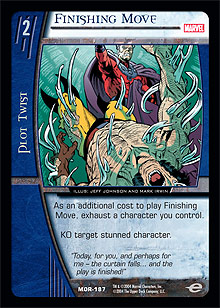 The Titans have a natural advantage against other weenie builds, namely because their characters are better overall and it has better control over combat. You want to force your opponent into combat to maximize these advantages. What gives combo weenie decks game against Titans is A Child Named Valeria. Fortunately, playing the full complement of Finishing Moves gives you an out. You want to set up a position where the opponent is forced to use Child and you respond by stunning either Invisible Woman or Mr. Fantastic with Roy or Terra. Then you want to use Finishing Move to KO the stunned character so that Child doesn’t come online properly when it resolves. This is not always easy, and there is no point doing it unless you can then go on to wreck the rest of your opponent’s board. However, it is really the most important strategic axis in these matchups and relatively easy to spot, as not many beatdown decks run Invisible Woman, Invisible Girl, or Mr. Fantastic, Reed Richards.
The Titans have a natural advantage against other weenie builds, namely because their characters are better overall and it has better control over combat. You want to force your opponent into combat to maximize these advantages. What gives combo weenie decks game against Titans is A Child Named Valeria. Fortunately, playing the full complement of Finishing Moves gives you an out. You want to set up a position where the opponent is forced to use Child and you respond by stunning either Invisible Woman or Mr. Fantastic with Roy or Terra. Then you want to use Finishing Move to KO the stunned character so that Child doesn’t come online properly when it resolves. This is not always easy, and there is no point doing it unless you can then go on to wreck the rest of your opponent’s board. However, it is really the most important strategic axis in these matchups and relatively easy to spot, as not many beatdown decks run Invisible Woman, Invisible Girl, or Mr. Fantastic, Reed Richards.
Versus Common Enemy
This deck just never seems to go away, although it often struggles with straight Curve decks like Sentinels. Its matchup with Titans is poorly understood. Common Enemy definitely has the tools to beat Titans, but the inverse is also true.
Similar to New School, Common Enemy’s MVP is the 4-drop Doom, but instead of Psimon, it works toward Thing, The Ever-Lovin’ Blue-Eyed Thing and then Silver Surfer for the lock. Unfortunately for them, you are much better equipped to deal with a single large characters than a series of smaller drops. Common Enemy beats you earlier than New School does, but you have Finishing Move and much more obvious attacks.
 The lack of Fizzle for this plan hurts the Common Enemy player, as teaming up is a vital part of the deck, even though it only runs four copies of its team-up. Being able to replay a turn with Foiled can help you delay the TELBET turn that little bit longer, which is often enough to win. Remember that at its heart, Common Enemy is still a curve deck with glorified tricks, and while it’s one of the more interesting and creative decks around, it still suffers from many of the vulnerabilities of curve. Reign of Terror and Mystical Paralysis are again key, but if you can engineer a successful Teen Titans Go!, it will be very hard to lose. Typically, your opponent wants to Reign your low drops and then Paralyze Garth, leaving you with only one attacker on turn 5. Because of this and Thing, the even initiative is a better bet, but you really need to know that you’re playing Common Enemy before choosing evens. As above, Foiled is devastating to Common Enemy, and the Roy Harper/Press interaction operates practically unfettered on turn 6.
The lack of Fizzle for this plan hurts the Common Enemy player, as teaming up is a vital part of the deck, even though it only runs four copies of its team-up. Being able to replay a turn with Foiled can help you delay the TELBET turn that little bit longer, which is often enough to win. Remember that at its heart, Common Enemy is still a curve deck with glorified tricks, and while it’s one of the more interesting and creative decks around, it still suffers from many of the vulnerabilities of curve. Reign of Terror and Mystical Paralysis are again key, but if you can engineer a successful Teen Titans Go!, it will be very hard to lose. Typically, your opponent wants to Reign your low drops and then Paralyze Garth, leaving you with only one attacker on turn 5. Because of this and Thing, the even initiative is a better bet, but you really need to know that you’re playing Common Enemy before choosing evens. As above, Foiled is devastating to Common Enemy, and the Roy Harper/Press interaction operates practically unfettered on turn 6.
Hopefully I have made clear what I consider some of the more successful approaches to playing the various Teen Titans matchups. The Titans possess a rare combination of power and flexibility, but their lack of a powerful late game (their only real weakness) demands that you pick the right plan the first time. I am happy to answer any emails at muly233@hotmail.comail, particularly about the matchups I didn’t cover. Until then, always be the one thinking two turns ahead!